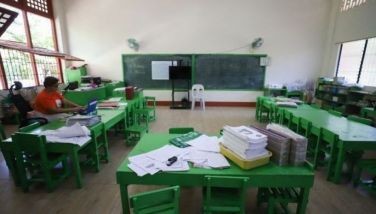Mining firm yet to pay fine, says Reyes
June 20, 2006 | 12:00am
Though it has already been a week since the environment department announced a 30-day trial period for Lafayette Philippines, Environment Secretary Angelo Reyes said the mining firm has not resumed operations as it has yet to pay the P10.4-million fine for allegedly causing mine spills in Rapu-Rapu last year.
Reyes, on the other hand, admitted that he has yet to send out a demand letter to the Australian mining firm. He explained that he was out of town during the past two days and was unable to attend to it.
"We already held a meeting at the pollution adjudication board (of the DENR) but I was not able to sign the letter as I was out of town for two days (but) I will send the letter now. We have asked them to come forward and pay the P10.4-million fine," Reyes said at the regular media forum at the Manila Hotel.
Last June 13, the DENR ruled that Lafayette would be able to resume its operations at the P1.4-billion Rapu-Rapu polymetallic project in Albay. The firm set up three phases for the 30-day trial run.
The first phase runs for five days wherein the DENR will observe the water system and make sure there are no leaks in the pumping system. It would take them nine days to get materials from the open pit and study the electromechanical adequacy of the system. They will gather rock samples during the remaining 16 days.
Throughout the test, the mining operations will be monitored by a team from the DENR 24 hours a day. They also encouraged the community to remain vigilant.
"We will organize ourselves so we can monitor the test run. I’ve already sent some personnel there," Reyes said.
Two mine spills occurred last Oct. 11 and 31 in alleged violation of the Clean Air Act, prompting President Arroyo to form the Rapu-Rapu Fact-Finding Commission (RRFFC).
Apart from the commission’s report, they also considered Lafayette’s side, referred to independent studies of the University of the Philippines-Natural Sciences Research Institute (UP-NSRI) and the Bureau of Fisheries and Aquatic Resources (BFAR), and sought the opinions of technical experts.
Reyes said the cyanide level exceeded the DENR’s standards by 633 times during the Oct. 11 spill, while the cyanide level was 356 times higher than the agency’s standards during the Oct. 31 spill. The high level of cyanide supposedly resulted in damage to marine life and caused residents to develop skin diseases.
Reyes, on the other hand, admitted that he has yet to send out a demand letter to the Australian mining firm. He explained that he was out of town during the past two days and was unable to attend to it.
"We already held a meeting at the pollution adjudication board (of the DENR) but I was not able to sign the letter as I was out of town for two days (but) I will send the letter now. We have asked them to come forward and pay the P10.4-million fine," Reyes said at the regular media forum at the Manila Hotel.
Last June 13, the DENR ruled that Lafayette would be able to resume its operations at the P1.4-billion Rapu-Rapu polymetallic project in Albay. The firm set up three phases for the 30-day trial run.
The first phase runs for five days wherein the DENR will observe the water system and make sure there are no leaks in the pumping system. It would take them nine days to get materials from the open pit and study the electromechanical adequacy of the system. They will gather rock samples during the remaining 16 days.
Throughout the test, the mining operations will be monitored by a team from the DENR 24 hours a day. They also encouraged the community to remain vigilant.
"We will organize ourselves so we can monitor the test run. I’ve already sent some personnel there," Reyes said.
Two mine spills occurred last Oct. 11 and 31 in alleged violation of the Clean Air Act, prompting President Arroyo to form the Rapu-Rapu Fact-Finding Commission (RRFFC).
Apart from the commission’s report, they also considered Lafayette’s side, referred to independent studies of the University of the Philippines-Natural Sciences Research Institute (UP-NSRI) and the Bureau of Fisheries and Aquatic Resources (BFAR), and sought the opinions of technical experts.
Reyes said the cyanide level exceeded the DENR’s standards by 633 times during the Oct. 11 spill, while the cyanide level was 356 times higher than the agency’s standards during the Oct. 31 spill. The high level of cyanide supposedly resulted in damage to marine life and caused residents to develop skin diseases.
BrandSpace Articles
<
>
- Latest
- Trending
Trending
Latest
Trending
Latest
Recommended


























